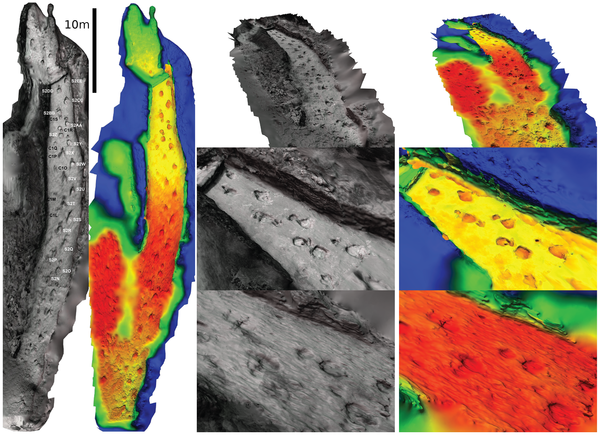It is inevitable that some important specimens will become lost or damaged over time, conservation is therefore of vital importance. The Paluxy River dinosaur tracksite is among the most famous in the world. In 1940, Roland T. Bird described and excavated a portion of the site containing associated theropod and sauropod trackways. This excavated trackway was split up and housed in different institutions, and during the process a portion was lost or destroyed. We applied photogrammetric techniques to photographs taken by Bird over 70 years ago, before the trackway was removed, to digitally reconstruct the site as it was prior to excavation. The 3D digital model offers the opportunity to corroborate maps drawn by R.T. Bird when the tracksite was first described. More broadly, this work demonstrates the exciting potential for digitally recreating palaeontological, geological, or archaeological specimens that have been lost to science, but for which photographic documentation exists.

R.T. Bird’s maps of the Paluxy ‘chase sequence.’
a) Bird’s Rye chart, b) the Austin chart, and c) the Austin and Rye charts overlaid. Note that the Austin and Rye charts diverge toward the north.

Photogrammetric reconstruction of Bird’s chase sequence.
Far left, photo-textured and height mapped plan-view of the reconstructed trackway. Track labels according to Farlow et al. (1989). Right, photo-textured and height mapped views, top to bottom; isometric view along trackway, close up of high fidelity southern end, close up of poor quality northern end.

Overlays of Bird’s Rye and Austin charts with photogrammetric and laser scan digital models.
a) The Rye chart, b) portion of the Rye chart reconstructed via photogrammetry with historical photos, c) Close-up of photogrammetric reconstruction, d) location of laser scans of the AMNH and TMM sections in the Rye chart, e) close-up of match between Rye chart and laser scans, f) Austin chart, g) Austin chart and photogrammetric reconstruction, h) Austin chart and laser scans of AMNH and TMM sections.
Ref:Falkingham PL, Bates KT, Farlow JO (2014) Historical Photogrammetry: Bird’s Paluxy River Dinosaur Chase Sequence Digitally Reconstructed as It Was prior to Excavation 70 Years Ago. PLoS ONE 9(4): e93247. doi:10.1371/journal.pone.0093247.Editor: Peter Dodson, University of Pennsylvania, United States of America
Key: WFS,Riffin T Sajeev,Russel T Sajeev,World Fossil Society



 December 7th, 2015
December 7th, 2015  Riffin
Riffin 
 Posted in
Posted in  Tags:
Tags: 